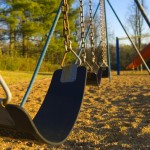How to Choose a Public Playground

Kids love climbing around and just plain exploring at playgrounds, which also gives moms and dads a break and moments to relax. We know that at some point, our kids get a little scrape or a bruise on a playground. However, it is easy to imagine how much worse an injury could be.
Not all playgrounds are created equal…
In recognition of this fact, the U.S. Consumer Product Safety Commission published the Public Playground Safety Handbook. In Pennsylvania, public playgrounds are required by law to adhere to the specifications in the Handbook. However, this does not mean that all playgrounds actually meet the standards.
Here are some common hazards, along with equipment characteristics to look for:
Clothing – Avoid clothing with drawstrings that could get tangled in equipment, and anything that interferes with movement.
Surfacing – The surface of the playground should be uniform, and slightly soft to prevent injuries from falls. Asphalt and even grass are not ideal surfaces. It should be apparent that the surface was intended for a playground, as indicated by a containment barrier in the case of wood chips.
Entanglement and Impalement – Look for sharp edges and protrusions from the equipment that could cut skin, or catch on clothes to become tangled.
Entrapment – See if there are any spaces between equipment where a child’s head could become stuck. They should not wear bike helmets while on the playground, their head could become lodged due to the extra width of the helmet.
Suspended Equipment – Be aware of anything that hangs down in high-traffic areas — a child’s neck, arm or head may catch it as they run by.
Tripping Hazards – Make sure the surface is flat with no holes or protrusions that could cause tripping, this includes anchors for the equipment.
Just use common sense, if the playground does not look well maintained, it’s probably not safe.

